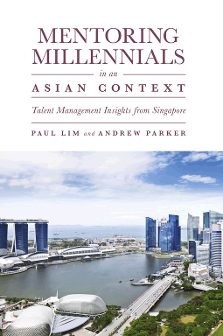
Index
Paul Lim
(Singapore Management University, Singapore)
Andrew Parker
(University of Exeter, UK)
Mentoring Millennials in an Asian Context
ISBN: 978-1-78973-484-3, eISBN: 978-1-78973-483-6
Publication date: 16 March 2020
This content is currently only available as a PDF
Citation
Lim, P. and Parker, A. (2020), "Index", Mentoring Millennials in an Asian Context, Emerald Publishing Limited, Leeds, pp. 151-153. https://doi.org/10.1108/978-1-78973-483-620201014
Publisher
:Emerald Publishing Limited
Copyright © >Copyright 2020 Paul Lim and Andrew Parker
INDEX
Affective commitment (AC)
, 42
Alternative types of mentoring
anonymous mentoring
, 28
international mentoring
, 27
peer mentoring
, 28
reverse mentoring
, 27, 30, 90, 95, 121
Artificial Intelligence (AI)
, 131
Baby boomers
, 4, 8
Benefits to a mentor
, 29–31
objective vs. subjective outcomes
, 30
Career functions
, 28–29
challenging assignments
, 87
coaching
, 87
exposure and visibility
, 86
sponsorship
, 86
Career outcomes
, 29
objective career outcomes
, 30
subjective career outcomes
, 30
China
, 3, 7, 9, 10, 12, 55
Coaching
executive coaching
, 24, 119
mentoring vs. coaching
, 24
Coding
, 60, 69
Continuance commitment (CC)
, 42, 43
Control variables
, 53
Cronbach’s Alpha
, 53
Data collection
, 55, 59
Dependent variable
, 51
Direct supervisor
, 23, 84, 90, 92, 134
Drafting
, 110
Electronic direct mailer (EDM)
, 111
Employee turnover
turnover vs. turnover intentions
, 35–36
voluntary turnover models
, 37–41
voluntary vs. involuntary turnover
, 36–37
Explanatory sequential design
mixed methods
, 47
reasons
, 47
Fast moving consumer goods (FMCG)
, 58
Formal mentoring
, 19–22
Generational cohorts
birth years
, 7
characteristics
, 5–8
definition
, 5
traits
, 5
Generation X
, 4, 8
Generation Y
, 4, 8
Generation Z
decision-making ability
, 130–132
information technology
, 128
multi-tasking
, 132
passion vs. process
, 129
relationships
, 132–133
short-term pain vs. long-term pain
, 129–130
Hypotheses
, 45–47
Independent variable
, 51
Informal mentoring
, 19–22
Initial meeting
, 103–104
Initiation
accepting and rejecting
, 102
mentor initiates
, 101
protégé initiates
, 101
Internet of Things (IOT)
, 130, 131
Interviewees
, 57, 59, 87, 95, 96
Interview sample
, 48–49, 58–59
Kathy Kram
, 28–29
Kram's mentoring functions
career functions
, 86–87
psychosocial functions
, 87–89
Limitations
, 53–55, 83, 95–97
Meeting procedures
asking questions
, 105
1st meeting
, 104
subsequent meetings
, 104–105
Mentoring
benefits
, 29–31
career advancement
, 28
career functions
, 28, 86, 87
crises
, 105–106
definition
, 15, 16–17
female mentoring
, 25, 124
gender and behaviours
, 102–103
gender preference
, 51, 90
human resources management
, 25–27
initiation
, 22–23, 32
internal vs. external
, 23–24
non-mentored vs. mentored
, 4
psychosocial functions
, 2, 26, 29, 86–89
training and development
, 27
turnover and turnover intentions
, 35–36
Mentoring myths
, 99–100
Mentoring styles
duration
, 89–90
formal mentoring
, 19–22
informal mentoring
, 19–22
MentorMe
, 112, 114, 119, 124
Mentor relationship
, 31–33, 107
Millennial
, 8, 127–133
attributes
, 11, 12
definition
, 10
dissimilar behaviours
, 10
materialism
, 11
organisational socialisation
, 11, 26
Mixed methods
, 47, 55
Moderating variable
, 52–53
Multi-national corporations (MNC)
, 58
Normative commitment (NC)
, 43
Objective career outcomes
, 30
OCBC Bank
, 109–126
Organisational commitment
affective commitment
, 42, 64
continuance commitment
, 42, 43, 64
normative commitment
, 42, 43, 64, 96
theory of side bets
, 42
three component model
, 42, 52, 53, 92
Organisational commitment questionnaire (OCQ)
, 52
Organisational socialisation
, 11, 26, 31
Permanent Residents (PR)
, 59
Phases of the mentor relationship
cultivation
, 32
initiation
, 32
redefinition
, 33
separation
, 32
Problem-Based Learning (PBL)
, 119
Psychosocial functions
, 28–29
acceptance and confirmation
, 88
counselling and friendship
, 88–89
role modelling
, 87–88
Qualitative section
, 55–62
Quantitative section
, 47–55
Questionnaires
, 46, 49–51, 54, 95, 116
Reliability
, 52
Research questions
, 45–47, 74, 81, 83, 84
Sampling procedure
, 49, 57–58
Singapore
, 109–126
employee turnover
, 3
millennials
, 2, 3, 10, 58
turnover intentions
, 1
unemployment rate
, 3
workplace
, 92
Singapore Armed Forces (SAF)
, 27
Slip-streaming
, 110
Small-medium enterprises (SME)
, 58
Study design
, 46–47
Subjective career outcomes
, 30
Supervisor
, 4
Turnover
economic turnover model
, 37
employee turnover (See Employee turnover)
image theory
, 39
intent to stay
, 35
job satisfaction
, 40
Lee and Mitchell
, 39
March and Simon
, 40–41
Mobley
, 38–39
process and content models
, 38
psychological turnover model
, 37–38
sociological turnover model
, 38
turnover intentions vs. turnover
, 35–36
voluntary turnover models
, 37–41
Variables
control variables
, 53
dependent variable
, 51
independent variable
, 51
moderating variable
, 52–53
- Prelims
- Chapter 1 Introduction
- Chapter 2 Generational Cohorts
- Chapter 3 The Millennial
- Chapter 4 Mentoring
- Chapter 5 Employee Turnover
- Chapter 6 Conducting the Study
- Chapter 7 Making Sense of the Data
- Chapter 8 Discussion, Interpretation and Conclusion
- Chapter 9 The Rubber Meets the Road
- Chapter 10 Case Study: OCBC Bank Singapore
- Chapter 11 Next in Line: Generation Z
- References
- Index